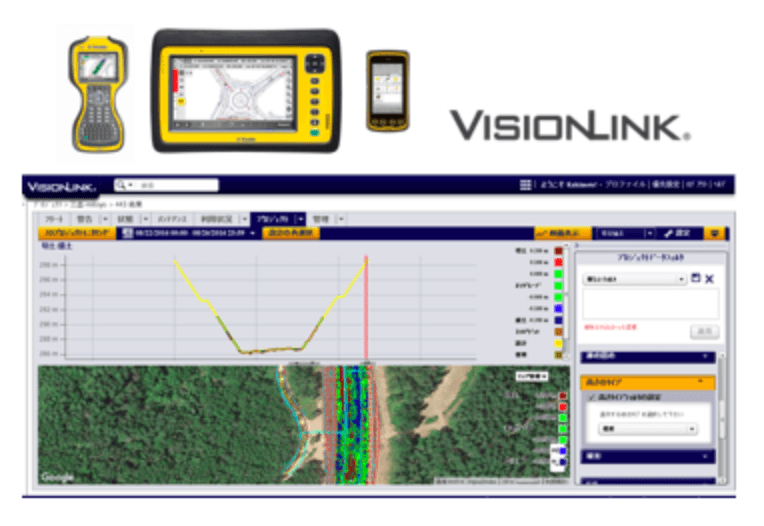IoT in the construction construction industry
Nikon · Trimble improves construction productivity with IoT technology

ABOUT
IoT technology improves construction site productivity as labor force decreases
Productivity hasn’t changed in the construction industry for a long time, especially when it comes to earth work. With almost a third of skilled construction workers set to retire in the next ten years, improving productivity will be required to address the future labor shortage.
The Ministry of Land, Infrastructure and Transportation recently learned of the situation and has introduced measures to solve this problem, including “full use of information and communications technology (ICT)” at construction sites.
Nikon · Trimble Corp. is promoting i-Construction, an effort to improve overall productivity and aim for a more attractive construction industry for future laborers.
This consists of utilizing surveying know-how to provide IoT sensors and displays for equipment and machinery that are operating at construction sites. In addition, Nikon · Trimble provides a construction support cloud service called “Trimble Connected Community”, also known as VISIONLINK, which transmits the data from the angle sensors and GPS devices that are are attached to the edge of machinery like excavators, to the cloud.
This enables laborers to view the location of the excavator in real time and facilitates the confirmation and tracking of on-site construction progress remotely. By introducing these capabilities, the management company of the IoT construction machinery can easily understand the operation time of the construction machine and the arrangement information, such as the consistency and efficiency of asset management, as well as the accuracy of the operational speed.
Laborers at the construction site have simplified processes such as tying and piling, indispensable components of construction, through the use of machine control. Once the equipment has finished excavating an area, laborers can can send the results by IoT to the cloud, including the location of the excavation and its depth.
With these new capabilities, construction site supervisors have more tools at their disposal. They can receive safety alerts, register 3D design data online from their personal computer, search for aerial photographs, see cross-sectional data of the excavation, and so much more.
They can even use the “remote assistant” function to monitor construction progress and respond to unexpected system problems on-site.
CHALLENGE
In order to collect IoT sensor information, a data communication SIM must be inserted into the gateway installed at the construction site. Data that is collected from the sensor is aggregated and then transmitted via cellular connectivity.
Many traditional data communication SIM cards are too expensive to monitor the hundreds of devices that operate at most construction sites. In addition, they often require extensive time to install, which can put construction projects behind schedule and budget.
Plus, construction sites can often be located near mountainous areas, lakes, rivers, and oceans, where data transmissions can be spotty depending on the service provider.
SOLUTION
Nikon · Trimble Corp needed to find IoT cellular connectivity that could provide quality data speeds in virtually any location.
Plus, they needed a solution that would be quick to implement so they could keep construction projects on schedule and on budget.
This led Nikon · Trimble to choose Soracom as their IoT cellular connectivity supplier.
WHY SORACOM
Nikon · Trimble powered their IoT project with Soracom for a variety of different reasons.
Firstly, the speed at which Soracom could be implemented into their operations was extremely valuable. Conventionally, it took around 10 business days from the purchasing of data communication SIM cards to the launch of the initiative. Plus, when preparing for a sudden request from a client, there was always an enormous inventory stock of SIM cards.
With Soracom, Nikon · Trimble’s inventory cost was virtually zero, and their SORACOM AIR SIM cards arrived in a day or two. Plus, the IoT cellular connectivity could be activate immediately through Soracom’s web-based user console.
Another reason why Nikon · Trimble partnered with Soracom was because of the ability to change the data communication speed on the web console. With their Trimble Connected Community program, low-speed data transfer is used for position information and machine log data. Otherwise, high-speed data transfer is necessary for larger tasks that handle 3D design and other extensive tasks.
With traditional data communication SIM cards, it’s necessary to physically go to the site and change the SIM if there’s a desire to alter the data communication speed.
Soracom’s web console allows individuals to change data communication speeds by simply clicking a single button. This greatly reduces the labor required, and since the communication status can be viewed from the Web console, it also improved Nikon · Trimble’s troubleshooting as well.

FUTURE PLANS
According to the Ministry of Land, Infrastructure and Transport, information and communications technology will be installed in 30% of the distribution machinery in circulation.
Nikon · Trimble will continue to use more ICTs, such as construction navigation systems and automatic piloting, in the future. In 3 years, they would like to build a business that can manage 100,000 terminals.
They plan on continuing to innovate design, construction, maintenance and asset management by analyzing the data that they acquire from their ICT construction machines and further visualizing today’s construction sites.